 W
WThe Adoration of the Shepherds is a painting by the Italian Renaissance painter Lorenzo di Credi, dating to about 1510. It is displayed in the Uffizi Gallery of Florence.
 W
WThe Alba Madonna is a c.1510 tondo (circular) painting by the Italian High Renaissance artist Raphael, depicting Mary, Jesus, and John the Baptist in a typical Italian countryside.
 W
WThe Aldobrandini Madonna is a painting from about 1509–1510 oil by the Italian renaissance artist Raphael. The picture is of the Virgin Mother, Christ child and infant John the Baptist, one of many paintings by Raphael with this trio. It is from early in his third, or Roman period, where distinctive changes are seen from his Umbrian or Florentine period in style, use of colour, and introduction of more natural subjects and settings.
 W
WAnnunciation is a 1505-1510 oil on canvas painting by Andrea Previtali, produced for the high altar of the church of Santa Maria Annunziata in Meschio, now a district of Vittorio Veneto, where it is still on show. It was produced before the Bergamo-born artist returned to his birthplace. It is signed ANDREA BERGOMENSIS IOANIS BELLINI DISCIPLINUS PINXIT and shows marked influence from Previtali's teacher Giovanni Bellini.
 W
WBaptism of Christ is a c.1510 painting of the Baptism of Christ by Pietro Perugino. He produced it for the chapel of St John the Baptist in Città della Pieve Co-Cathedral, where it still hangs. Unusually for a depiction of this subject, it does not show the face of God the Father. A multi-coloured marble frame was added in the Baroque period and a copy of Perugino's self-portrait now hangs another wall in the chapel.
 W
WThe Barrymore Madonna is a 1508–1510 painting by Antonio da Correggio.
 W
WThe Dead Christ Held by Two Angels is a painting by the Italian Renaissance artist Marco Palmezzano, finished in 1510. It is housed in the Musée du Louvre of Paris, France.
 W
WThe Disputation of the Sacrament, or Disputa, is a painting by the Italian Renaissance artist Raphael. It was painted between 1509 and 1510 as the first part of Raphael's commission to decorate with frescoes the rooms that are now known as the Stanze di Raffaello, in the Apostolic Palace in the Vatican. At the time, this room was known as the Stanza della Segnatura, and was the private papal library where the supreme papal tribunal met.
 W
WThe Gypsy Madonna is a panel painting of the Madonna and Child in oils of about 1510–11, by Titian, now in the Kunsthistorisches Museum in Vienna. It is a painting made for display in a home rather than a church.
 W
WHoly Family with a Shepherd is a c.1510 painting by Titian, now in the National Gallery, London. It has also previously been attributed to Paris Bordone. It has previously been dated to around 1516 due to its colouring's similarities to the Balbi Holy Conversation of c.1516. The c.1510 date, based on the similarity of its figure of Saint Joseph to that of St. Mark Enthroned, is now more widely accepted. It shows Titian still under the influences of Giorgione and Giovanni Bellini, which also favours the c.1510 dating.
 W
WHoly Family with Saints Elizabeth and John the Baptist is an oil on panel painting, dating to around 1510, sometimes attributed to Correggio. It measures 28 by 21.5 cm and is now in the Pinacoteca Malaspina in Pavia.
 W
WThe Immaculate Conception with Saints is a painting by the Italian Renaissance painter Piero di Cosimo, executed between 1485 and 1505. It is housed in the Uffizi Gallery of Florence, Italy.
 W
WThe Infant Bacchus or Young Bacchus is a 1505–1510 painting of the Roman god Bacchus as a boy by Giovanni Bellini. Originally painted on panel, it was later transferred to canvas.
 W
WThe Judgement of Solomon is a c.1505–1510 oil on canvas painting by Sebastiano del Piombo of the Judgement of Solomon, now in the Bankes collection at Kingston Lacy, a National Trust property in Dorset, UK.
 W
WJudith and Her Maidservant or Judith and Her Maidservant with the Head of Holofernes is a circa 1510–1514 oil on panel painting by Correggio, now in the Musée des Beaux-Arts of Strasbourg, France. Its inventory number is 252.
 W
WThe Lochis Madonna is an oil on panel painting attributed to Titian and dated to around 1508-1510. It is now in the Accademia Carrara in Bergamo. It is first recorded as part of the Lochis collection, after which it is named.
 W
WThe 'Madonna and Child or Madonna with the Christ Child Blessing is a 1510 oil on panel painting by Giovanni Bellini, painted when he was already in his eighties but still responding to new developments in painting. It is similar to the 1505 Madonna del Prato and the 1509 Madonna and Child. It is now in the Pinacoteca di Brera in Milan.
 W
WMadonna and Child is a c. 1510 painting by Giovanni Bellini, now in the Galleria Borghese in Rome. It can be compared with the 1510 Madonna and Child (Brera), the 1505 Madonna del Prato (London) and the 1509 Madonna and Child (Detroit).
 W
WMadonna and Child with Saints Elizabeth and John the Baptist is an oil on panel painting by Correggio, measuring 61 x 48 cm. It dates to around 1510 and is now in the Philadelphia Museum of Art.
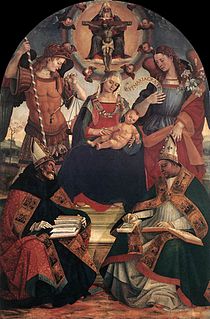 W
WMadonna and Child with the Holy Trinity and Two Saints is a 1510 painting by Luca Signorelli, now in the Uffizi in Florence. It is a sacra conversazione, with the Madonna enthroned between Michael and Gabriel, with Augustine (left) and Athanasius (right) below and the Holy Trinity above.
 W
WThe Madonna of Loreto is a painting finished around 1511 by the Italian High Renaissance painter Raphael. It is housed in the Musée Condé of Chantilly, France.
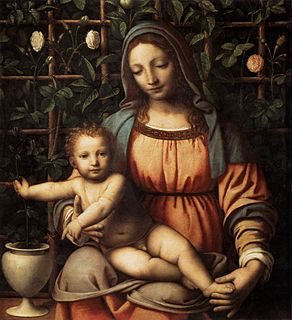 W
WMadonna of the Rose Garden is a c.1510 oil on panel painting by Bernardino Luini, now in the Pinacoteca di Brera in Milan, which acquired it from the Giuseppe Bianchi collection in 1826.
 W
WA Man with a Quilted Sleeve is a painting of about 1510 by the Venetian painter Titian in the National Gallery, London, measuring 81.2 by 66.3 centimetres. Though the quality of the painting has always been praised, there has been much discussion as to the identity of the sitter. It was long thought to be a portrait of Ariosto, then a self-portrait, but in 2017 is called Portrait of Gerolamo (?) Barbarigo by the gallery, having also been called merely Portrait of a Man, the title used here, The Man with the Blue Sleeve, and no doubt other variants.
 W
WThe Martyrdom of Saint Barbara is an early 16th century painting by German artist Lucas Cranach the Elder. It is in the collection of the Metropolitan Museum of Art.
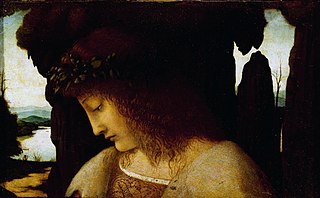 W
WNarcissus at the Fountain is a 1500–1510 oil-on-panel painting by Giovanni Antonio Boltraffio, now in the Uffizi in Florence. A copy is now in the National Gallery, London. Both works show a young man in profile, interpreted as Narcissus due to his downward gaze.
 W
WNoli me tangere is a c.1510 oil on canvas painting by Andrea del Sarto. It was the first he produced for the Augustinian San Gallo church in Florence, as recorded by Anonimo Magliabechiano and in Vasari's Lives of the Artists, and he later produced the San Gallo Annunciation and The Disputation on the Trinity for the same church. It is now in the Uffizi.
 W
WThe Palazzo della Ragione Madonna is a fragment of a fresco of c. 1509–10 by Bramantino, originally on the façade of the Palazzo della Ragione, Milan, and now in the Pinacoteca di Brera in the same city. Due to a reference by Giovanni Paolo Lomazzo it was long misattributed to Bramante, until it entered its present home in 1808.
 W
WPortrait of a Cardinal, or simply The Cardinal, is an oil on panel painting by the Italian Renaissance artist Raphael, dated to c. 1510–1511. It is held by the Prado Museum in Madrid.
 W
WPortrait of a Young Woman is a c.1510 oil on canvas painting, usually attributed to Rosso Fiorentino, though Giovanni Larciani has also recently been suggested as its artist. It is now in the Uffizi in Florence. It is usually thought to be an early work by Rosso, produced before the frescos of the Chiostrino dei Voti at Santissima Annunziata, Florence, though its sharp style makes it hard to give a definite attribution to Rosso.
 W
WThe Rest on the Flight into Egypt is an oil painting of around 1510 by the Flemish painter Gerard David now in the National Gallery of Art in Washington. It can be compared with other works on the same theme by the same painter in the New York, the Madrid and Antwerp and a Virgin and Child in Rotterdam.
 W
WNunc Dimittis or Sacred Conversation is a 1505–1510 oil on panel painting by Giovanni Bellini. It measures 62 cm by 83 cm and is now in the Museo Thyssen-Bornemisza in Madrid. It belongs to the sacra conversazione genre and shows Anna and Simeon with the Madonna and Child.
 W
WSalome with the Head of John the Baptist or The Daughter of Herodias is a circa 1510 oil on panel painting by Sebastiano del Piombo, now in the National Gallery, London, to which it was left by Salting in 1910. The work could also show Judith with the head of Holofernes, though the presence of a vase is more likely to confirm it as Salome. The painting's model was also shown in the artist's St John Chrysostom Altarpiece as Mary Magdalene and in Woman as a Wise Virgin, both of a similar date.
 W
WThe Ascension of Christ is a painting by Italian Renaissance master Perugino, dating from around 1510. It is housed in the Cathedral of Sansepolcro, Tuscany, central Italy.
 W
WScenes from Tebaldeo's Eclogues is a set of four small square oil on panel paintings by Andrea Previtali, now in the National Gallery, London. They show scenes from the Ferrarese writer Antonio Tebaldeo's eclogue on the life of Damon of Athens, featuring his friend Thyrsis and Damon's love for Amaryllis. They were probably originally part of a piece of furniture for a rich Venetian noble family. Previtali's master Giovanni Bellini also produced furniture with scenes from the same book.
 W
WLa Schiavona, also known as Portrait of a Lady, is a 1510–1512 portrait by Titian of an unknown woman. The painting was being referred to as La Schiavona before the beginning of the seventeenth century. However, this name is traditional, given to the painting by someone in recognition of the style of her dress and her physiognomy. In reality, the lady portrayed would have been part of the nobility of the time, with a costume compatible with that of the wealthy women of the territories controlled by the Republic of Venice. Some people have tried to identify the woman as Catherine Cornaro, a hypothesis without any confirmation. Previously assigned to Giorgione, the painting is today commonly accepted as a youthful masterpiece by Titian; further evidence is provided by the absence of the modulated sweetness of the painter from Castelfranco Veneto, replaced rather by a pulsating vitality. There are also close similarities with the woman protagonist of the Miracolo del neonato, a Paduan fresco by Titian dating back to 1511.
 W
WThe Self-portrait of Giorgione is a possible self-portrait by the Italian painter Giorgione, now in the Museum of Fine Arts in Budapest. It is not universally accepted as an autograph work but - if it is - it is thought to be based on the c.1509-1510 Self-portrait as David now in the Herzog Anton Ulrich Museum.
 W
WSelf-Portrait as David is a c.1509-1510 oil on panel portrait by Giorgione, now in the Herzog Anton Ulrich Museum in Brunswick. It is not universally accepted as an autograph work but - if it is - it is thought to be the prototype for another Self-Portrait by the artist himself or an assistant.
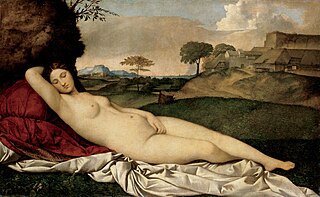 W
WThe Sleeping Venus, also known as the Dresden Venus, is a painting traditionally attributed to the Italian Renaissance painter Giorgione, although it has long been usually thought that Titian completed it after Giorgione's death in 1510. The landscape and sky are generally accepted to be mainly by him. In the 21st century, much scholarly opinion has shifted further, to see the nude figure of Venus as also painted by Titian, leaving Giorgione's contribution uncertain. It is in the Gemäldegalerie, Dresden. After World War II, the painting was briefly in possession of the Soviet Union.
 W
WSt Augustine is a 1510 oil on silk painting of Augustine of Hippo by Pinturicchio, painted as a gonfalon or processional banner for the Sant'Agostino company of flagellants in Perugia. When that order was suppressed, the work was moved to the Galleria Nazionale dell'Umbria, its present owner.
 W
WSt. Mark Enthroned is an early painting by the Italian Renaissance artist Titian, executed in 1510 or 1511, which is still in the church of Santa Maria della Salute in Venice.
 W
WWoman as a Wise Virgin is a circa 1510 oil on canvas painting by Sebastiano del Piombo, now in the National Gallery of Art in Washington.
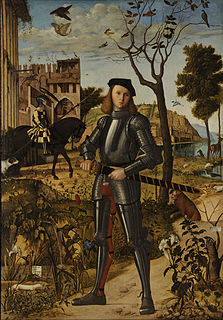 W
WYoung Knight in a Landscape, or Portrait of a Knight, is a painting by the Italian Renaissance artist Vittore Carpaccio, now in the Thyssen-Bornemisza Collection in Madrid. Dated 1510, this is the earliest full-length portrait in Western painting—on the assumption that it is a portrait, as seems likely. It is characteristic of Carpaccio that apart from this important innovation, the style of the work seems in other respects to look back to the previous century. From some date until the 20th century the painting had been given the monogram of Albrecht Dürer, and Carpaccio's signature overpainted. The realism and detail of Carpaccio does in fact show Northern influence.